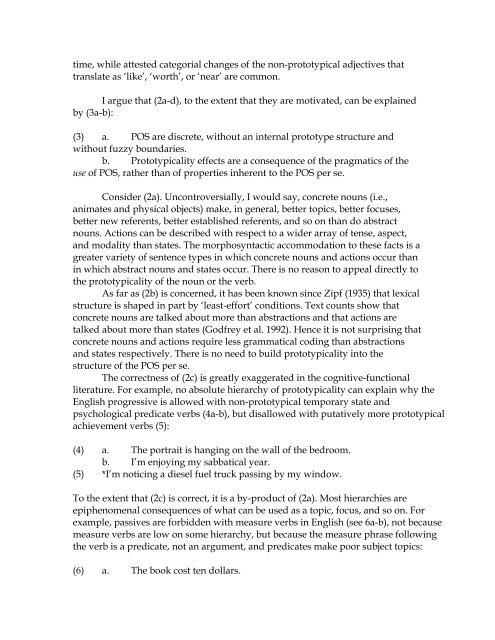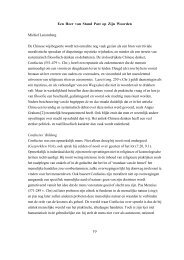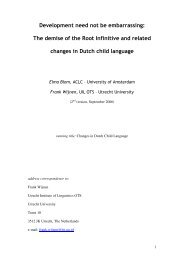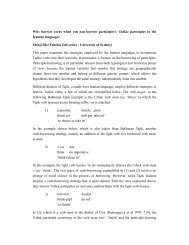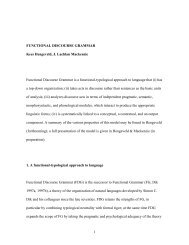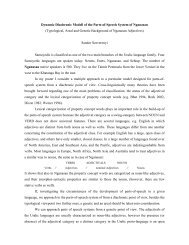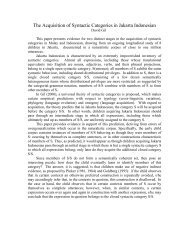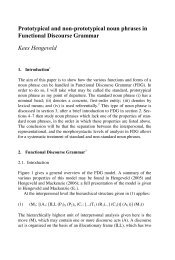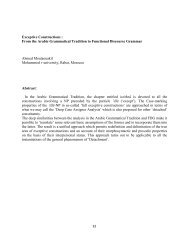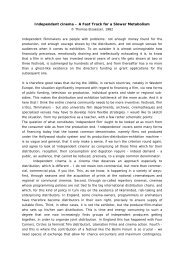The Intersection of formal grammar and pragmatics
The Intersection of formal grammar and pragmatics
The Intersection of formal grammar and pragmatics
Create successful ePaper yourself
Turn your PDF publications into a flip-book with our unique Google optimized e-Paper software.
time, while attested categorial changes <strong>of</strong> the non-prototypical adjectives that<br />
translate as ‘like’, ‘worth’, or ‘near’ are common.<br />
I argue that (2a-d), to the extent that they are motivated, can be explained<br />
by (3a-b):<br />
(3) a. POS are discrete, without an internal prototype structure <strong>and</strong><br />
without fuzzy boundaries.<br />
b. Prototypicality effects are a consequence <strong>of</strong> the <strong>pragmatics</strong> <strong>of</strong> the<br />
use <strong>of</strong> POS, rather than <strong>of</strong> properties inherent to the POS per se.<br />
Consider (2a). Uncontroversially, I would say, concrete nouns (i.e.,<br />
animates <strong>and</strong> physical objects) make, in general, better topics, better focuses,<br />
better new referents, better established referents, <strong>and</strong> so on than do abstract<br />
nouns. Actions can be described with respect to a wider array <strong>of</strong> tense, aspect,<br />
<strong>and</strong> modality than states. <strong>The</strong> morphosyntactic accommodation to these facts is a<br />
greater variety <strong>of</strong> sentence types in which concrete nouns <strong>and</strong> actions occur than<br />
in which abstract nouns <strong>and</strong> states occur. <strong>The</strong>re is no reason to appeal directly to<br />
the prototypicality <strong>of</strong> the noun or the verb.<br />
As far as (2b) is concerned, it has been known since Zipf (1935) that lexical<br />
structure is shaped in part by ‘least-effort’ conditions. Text counts show that<br />
concrete nouns are talked about more than abstractions <strong>and</strong> that actions are<br />
talked about more than states (Godfrey et al. 1992). Hence it is not surprising that<br />
concrete nouns <strong>and</strong> actions require less grammatical coding than abstractions<br />
<strong>and</strong> states respectively. <strong>The</strong>re is no need to build prototypicality into the<br />
structure <strong>of</strong> the POS per se.<br />
<strong>The</strong> correctness <strong>of</strong> (2c) is greatly exaggerated in the cognitive-functional<br />
literature. For example, no absolute hierarchy <strong>of</strong> prototypicality can explain why the<br />
English progressive is allowed with non-prototypical temporary state <strong>and</strong><br />
psychological predicate verbs (4a-b), but disallowed with putatively more prototypical<br />
achievement verbs (5):<br />
(4) a. <strong>The</strong> portrait is hanging on the wall <strong>of</strong> the bedroom.<br />
b. I’m enjoying my sabbatical year.<br />
(5) *I’m noticing a diesel fuel truck passing by my window.<br />
To the extent that (2c) is correct, it is a by-product <strong>of</strong> (2a). Most hierarchies are<br />
epiphenomenal consequences <strong>of</strong> what can be used as a topic, focus, <strong>and</strong> so on. For<br />
example, passives are forbidden with measure verbs in English (see 6a-b), not because<br />
measure verbs are low on some hierarchy, but because the measure phrase following<br />
the verb is a predicate, not an argument, <strong>and</strong> predicates make poor subject topics:<br />
(6) a. <strong>The</strong> book cost ten dollars.


